
Fundamentals
The profound journey into the meaning of ‘Coiled Hair Conditioners’ begins not in a laboratory, but in the very fiber of identity and the tender, ancient practices that honored textured hair. At its simplest, a coiled hair conditioner is a substance designed to impart softness, pliability, and health to hair strands that naturally form spirals, helices, and intricate S-patterns. This distinct hair type, prevalent within Black and mixed-race communities across the globe, possesses a unique architecture, demanding specialized care to thrive. The very designation, ‘Coiled Hair Conditioners,’ speaks to a recognition of difference, an acknowledgement that one size does not fit all in the vast expanse of hair traditions.
The core purpose of these preparations has always been to address the inherent characteristics of coiled hair. Due to its helical shape, the cuticle layers of a coiled strand are often raised, making it susceptible to moisture loss and increased friction. This structural reality means that conditioning is not merely a cosmetic endeavor; it forms the bedrock of hair health and resilience.
It is about infusing the hair with humectants and emollients that draw in and seal moisture, reducing breakage and enhancing manageability. From the earliest times, communities understood this elemental need, finding solace and efficacy in natural bounty.

Early Manifestations of Hair Conditioning
The practice of applying nourishing agents to coiled hair is as old as the heritage itself. Long before the term “conditioner” entered our lexicon, ancestral communities across Africa and its diaspora understood the principles of hair protection and replenishment. Their methods, often intertwined with daily life, ritual, and communal bonding, served as the genesis of what we today call coiled hair conditioning. The knowledge, passed through generations, was a living archive of remedies and care.
- Plant Oils ❉ Shea butter, coconut oil, argan oil, and palm oil, extracted and processed with ancestral ingenuity, provided essential moisture and lubrication.
- Herbal Infusions ❉ Decoctions of roots, leaves, and barks, known for their strengthening and soothing properties, were often rinsed through the hair after cleansing.
- Natural Clays ❉ Certain mineral-rich clays were mixed with water or oils to cleanse and purify, simultaneously depositing minerals that could contribute to hair’s vitality.
These rudimentary yet profoundly effective forms of conditioning laid the groundwork for modern formulations. They illustrate a deep, intuitive understanding of hair biology—a wisdom woven into the fabric of daily life and communal support. The very act of preparing these agents often became a ritual itself, a moment of connection to the earth and to one another.

The Fundamental Role in Hair Health
In its most basic interpretation, the coiled hair conditioner acts as a guardian against environmental stressors and mechanical damage. Without sufficient lubrication and moisture, coiled strands can easily snag, tangle, and break, leading to diminished length retention and overall vitality. The application of a conditioner smooths the outer cuticle, reducing friction between individual hair fibers. This smoothing action creates a reflective surface, enhancing the natural sheen of coiled hair, a characteristic long celebrated in various cultural contexts.
Coiled hair conditioners, in their most elemental form, serve as historical bridges connecting ancestral wisdom of moisture and protection with contemporary hair science.
Understanding the fundamentals of coiled hair conditioners requires acknowledging their dual function ❉ immediate hair enhancement and long-term strand protection. It is a protective sheath and a hydrating embrace, a shield and a soothing balm, all designed to allow coiled hair to flourish in its innate magnificence. This foundational comprehension paves the way for a deeper exploration into its cultural meaning and scientific intricacies.
| Traditional Agent Shea Butter (Karité) |
| Ancestral Benefit Rich moisture, scalp soothing, protective barrier against sun and wind. |
| Modern Scientific Link High in fatty acids (oleic, stearic), vitamins A & E, provides emolliency and antioxidant protection. |
| Traditional Agent Coconut Oil |
| Ancestral Benefit Deep penetration, protein retention, luster, detangling aid. |
| Modern Scientific Link Lauric acid content allows unique penetration of hair shaft, reducing protein loss. |
| Traditional Agent Hibiscus (Zobo, Roselle) |
| Ancestral Benefit Scalp health, softening, strengthening, natural color enhancement. |
| Modern Scientific Link Mucilage for slip, amino acids for strength, antioxidants for scalp health. |
| Traditional Agent These ancestral ingredients show a continuous lineage of understanding hair's needs, often validated by contemporary chemical analysis. |

Intermediate
Moving beyond the basic explication, the intermediate meaning of ‘Coiled Hair Conditioners’ delves into the specific biophysical challenges presented by coily textures and the strategic development of formulations to meet these distinct needs. It involves an appreciation for the subtle yet significant variations within the coiled hair spectrum—from loose spirals to tightly packed Z-patterns—and how these differences influence product efficacy and application. This level of understanding acknowledges that a conditioner for coiled hair is not a monolithic concept, but a diverse category of products designed with precision.

The Biophysical Uniqueness of Coiled Hair
Coiled hair possesses unique characteristics that set it apart from straighter textures. The elliptical shape of the hair follicle, coupled with the frequent twists and turns along the hair shaft, creates natural points of weakness where the cuticle layers can lift. This structural configuration impacts the hair’s ability to retain moisture and distribute natural sebum from the scalp effectively. Understanding this intrinsic biology is paramount to appreciating the intermediate functions of a coiled hair conditioner.
- Porosity Management ❉ Coiled hair often exhibits varying levels of porosity, from low (cuticles tightly bound) to high (cuticles more open). Conditioners are designed to either open cuticles slightly to allow moisture in (low porosity) or seal them down to retain moisture (high porosity).
- Friction Reduction ❉ The frequent bends in coiled strands increase inter-fiber friction, leading to tangles and breakage. Conditioners provide a lubricating film, enabling smoother movement between strands.
- Elasticity Enhancement ❉ Well-conditioned hair possesses improved elasticity, allowing it to stretch and return to its original shape without breaking. This resilience is vital for styling and daily manipulation.
The application of these agents is thus a sophisticated dance with the hair’s natural inclinations, aiming to optimize its inherent qualities rather than alter its fundamental nature. It is a science deeply informed by generations of practical application.

Evolution of Conditioning Practices and Ingredients
The intermediate understanding bridges ancient wisdom with emerging chemical insights. Ancestral practices for conditioning coiled hair, though devoid of formal chemical nomenclature, often utilized ingredients whose properties are now scientifically validated. The discernment passed down through oral traditions and communal learning enabled caretakers to select plants, oils, and minerals that intuitively understood the needs of coiled textures.
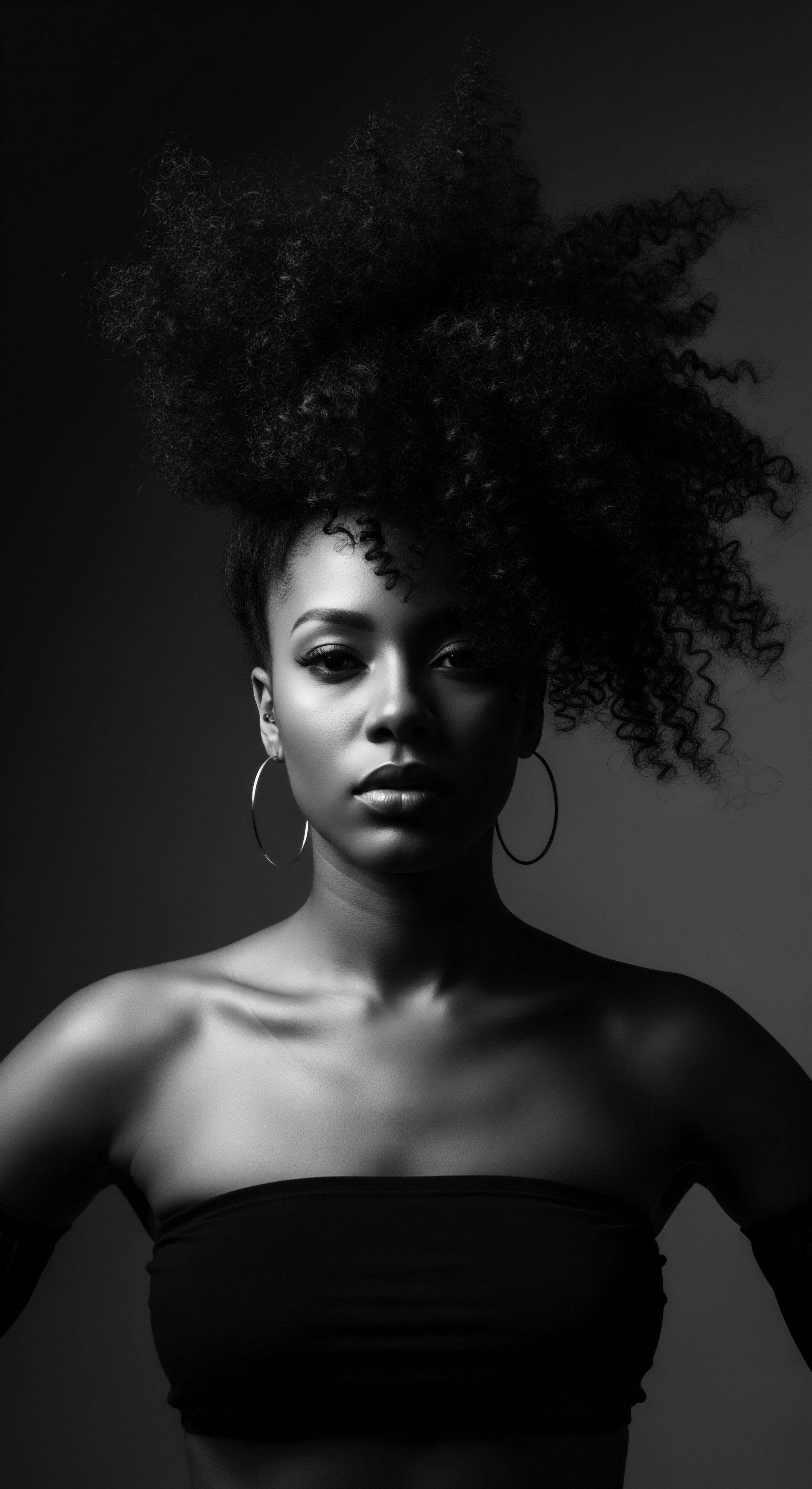
From Earth to Emulsion ❉ The Journey of Hair Care
Consider the widespread use of mucilaginous plant extracts in many West African and Caribbean communities. Plants like okra, flaxseed, and even the slippery inner bark of the elm or sassafras tree, were processed to yield viscous liquids used as detanglers and conditioners. This knowledge was transmitted through direct experience and observation within communal settings.
These traditional formulations, while simple, provided remarkable slip and hydration, attributes that are central to modern conditioning agents. The development of emulsions, allowing oil and water to mix seamlessly, represented a significant leap in conditioner technology, offering more stable and effective delivery systems for these beneficial components.
The journey of coiled hair conditioners from ancient plant extracts to sophisticated emulsions reflects humanity’s continuous pursuit of nurturing textured hair.
This historical continuity highlights a profound insight ❉ the underlying principles of effective conditioning have remained consistent, even as the methods and materials have evolved. The meaning of ‘Coiled Hair Conditioners’ at this intermediate stage is therefore a testament to both enduring ancestral knowledge and scientific progress.

The Sociocultural Significance of Hair Care Rituals
Beyond the purely scientific, coiled hair conditioning holds immense sociocultural significance. The act of conditioning is often a ritual, a moment of intimate care and connection. For many Black and mixed-race individuals, hair care routines, including the conditioning step, are inherited practices, passed from elder to child. These moments on the lap of a grandmother or aunt, with fingers working through coils, transcend mere product application.
They transmit stories, resilience, and identity. These practices are not isolated events; they are embedded within a larger narrative of self-acceptance and cultural affirmation. The conditioner, in this context, becomes a tool for preserving not just hair, but also heritage.
- Communal Bonding ❉ Hair care sessions historically served as gathering points, fostering conversation, mentorship, and the sharing of traditions.
- Self-Acceptance ❉ The consistent conditioning of natural coils promotes manageability, helping individuals to appreciate and work with their intrinsic hair texture.
- Ritualistic Cleansing ❉ Conditioning often follows cleansing, symbolizing a renewal, not only for the hair but also for the spirit.
Thus, the intermediate understanding of ‘Coiled Hair Conditioners’ acknowledges their role as both a scientific formulation and a cultural artifact, embodying a deeper commitment to the health and celebration of textured hair. This perspective honors the multifaceted ways these preparations interact with hair, body, and spirit.
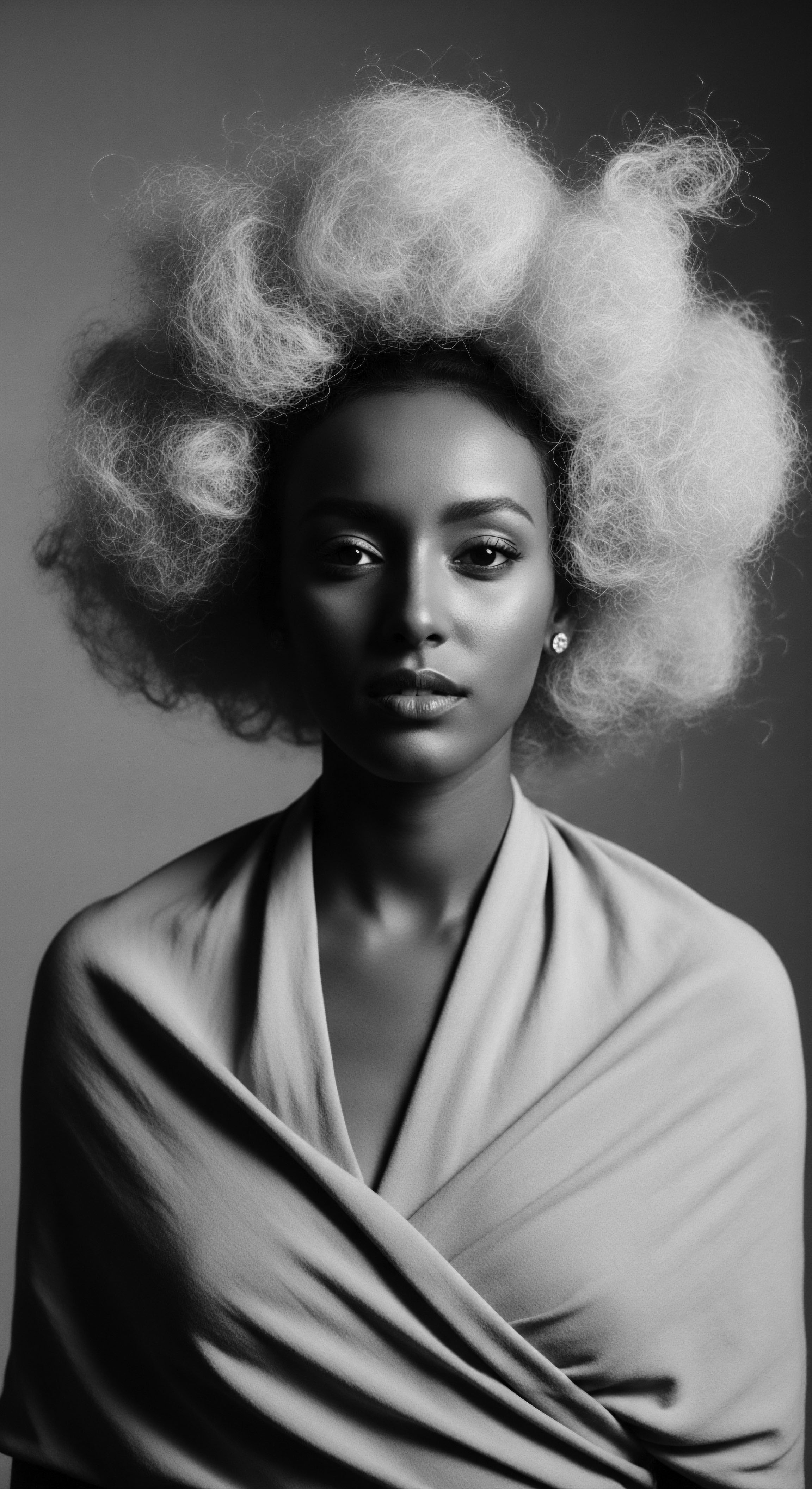
Academic
The academic elucidation of ‘Coiled Hair Conditioners’ transcends simple definitions, entering a realm of multidisciplinary inquiry that probes their complex biological interactions, socio-historical trajectories, and profound implications for identity formation within textured hair communities. From a scholarly vantage point, a coiled hair conditioner represents a sophisticated chemical or natural formulation, engineered to mitigate specific structural vulnerabilities of elliptical hair shafts and highly coiled keratin fibers, thereby optimizing their mechanical integrity, hydration status, and aesthetic presentation. Its meaning is not static; it is dynamically shaped by advancements in trichology, material science, ethnobotany, and critical race theory, perpetually reflecting the evolving relationship between Black and mixed-race individuals and their hair.

Deep Dive into Hair Biomechanics and Conditioner Function
From a biochemical perspective, the efficacy of coiled hair conditioners hinges upon their capacity to modulate the hair fiber’s surface properties and internal moisture content. Coiled hair, characterized by its non-circular cross-section and numerous helical twists, experiences disproportionately high levels of inter-fiber friction and a compromised ability to retain moisture compared to straight hair. The elevated cuticular scales, a common feature of tightly coiled strands, act as potential snag points, leading to increased vulnerability to mechanical damage during manipulation.
Conditioners for coiled hair are thus meticulously designed to address these specific biomechanical stressors. Their primary active ingredients, typically cationic surfactants, polymers, and a diverse array of emollients (including natural oils and butters), function synergistically. Cationic surfactants, with their positively charged heads, are attracted to the negatively charged surface of damaged hair, neutralizing the charge and smoothing the cuticular layers. This deposition reduces friction, enhancing detangling and preventing further mechanical abrasion.
Polymers, meanwhile, form a flexible film around the hair shaft, providing a protective barrier and improving elasticity. Emollients penetrate the cuticle or coat the exterior, sealing in moisture and imparting softness.

Osmotic Potential and Hydration Dynamics
The hydration dynamics of coiled hair are particularly complex. The often-observed high porosity in coiled textures, resulting from raised cuticles, means that while water can readily enter the hair shaft, it can also escape just as easily. This necessitates conditioning agents that not only deliver moisture but also create a substantive barrier against its evaporation.
Humectants like glycerin or panthenol draw water from the atmosphere into the hair, while occlusive agents (such as heavy oils or silicones, if used) then lock that moisture within the fiber. The sophisticated interplay of these components is central to preventing hygral fatigue—the weakening of the hair fiber due to repeated swelling and deswelling—a significant concern for coiled hair types.
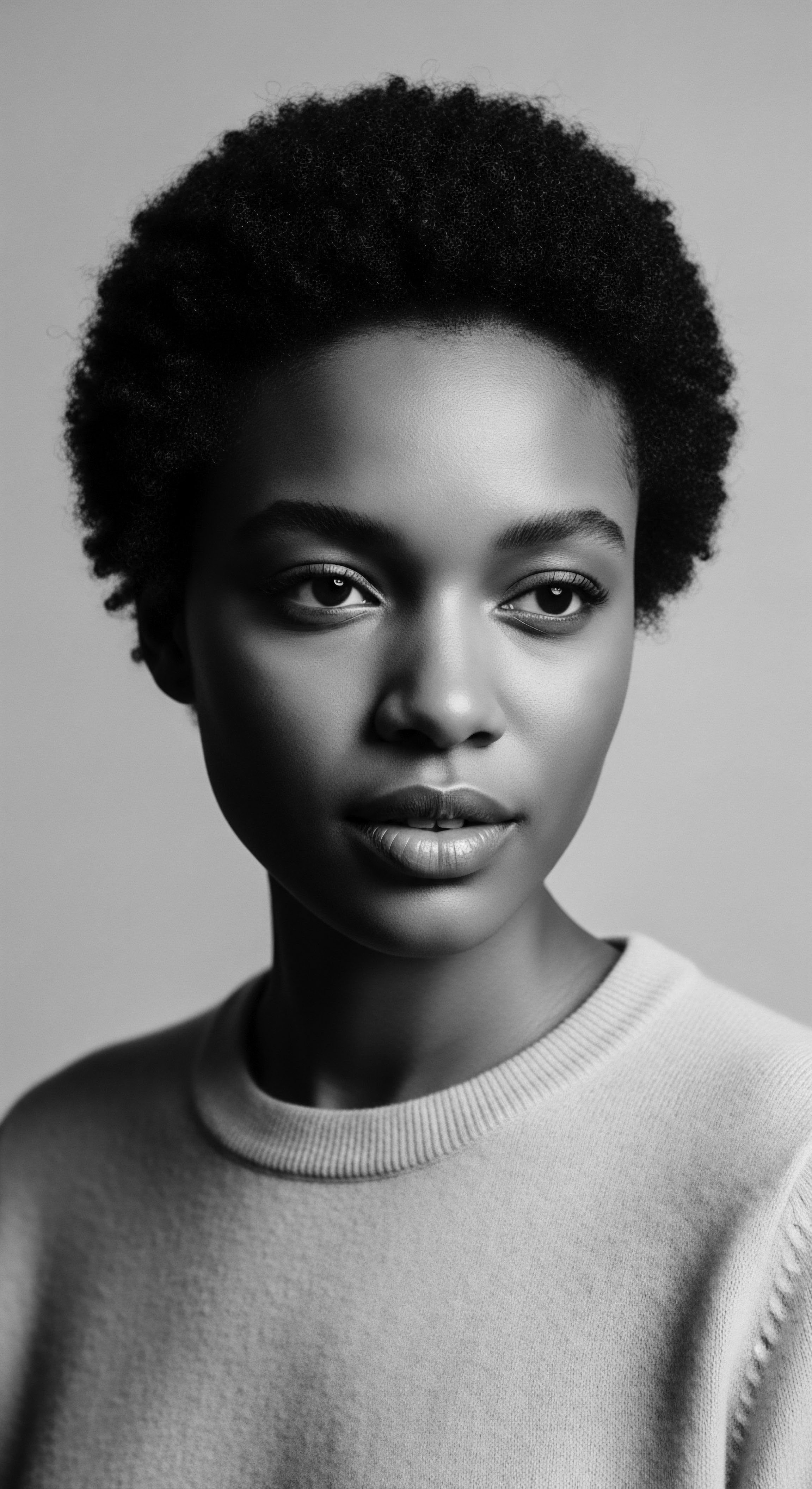
Cultural Epistemologies and the Materiality of Care
The academic meaning of ‘Coiled Hair Conditioners’ extends beyond the laboratory to encompass their profound role within cultural epistemologies and the materiality of care. Historical records and ethnographic studies reveal a continuous lineage of specialized hair care for coiled textures in African and diasporic communities, predating the industrial manufacture of “conditioners.” These traditional practices represent sophisticated systems of knowledge, empirically developed and communally transmitted, often intertwined with health, spiritual wellness, and social status.
Academic discourse reveals that coiled hair conditioners are not merely products but cultural artifacts, embodying historical resilience and evolving identities within textured hair communities.
A powerful, yet often under-cited, historical example of this ancestral knowledge is the meticulous use of nkuto (shea butter) by the Dagomba people of Ghana and other West African communities. For centuries, shea butter, extracted from the nuts of the shea tree (Vitellaria paradoxa), was not just a commodity but a cornerstone of hair and skin care. Women meticulously processed the nuts, often through communal effort, to produce a rich, emollient butter. This butter was regularly applied to hair, particularly children’s hair, to soften, detangle, and protect coiled strands from the harsh dry seasons and sun.
Its application was a daily ritual, performed by mothers and grandmothers, signifying nurturing and the transmission of generational wisdom (Opoku & Akweley, 2017). This traditional practice, understood as deeply conditioning, prevented breakage and maintained the pliability of the hair, allowing for intricate styling that communicated social status, age, and tribal affiliation. Modern scientific analysis validates this ancestral wisdom ❉ shea butter is rich in fatty acids (oleic, stearic, linoleic) and unsaponifiable components (triterpene alcohols, karitenes, phenols), which confer exceptional emollient, anti-inflammatory, and antioxidant properties, making it an ideal protective and moisturizing agent for coiled hair. This indigenous knowledge system, refined over millennia, demonstrates a profound, applied understanding of conditioning principles long before Western scientific frameworks articulated them.
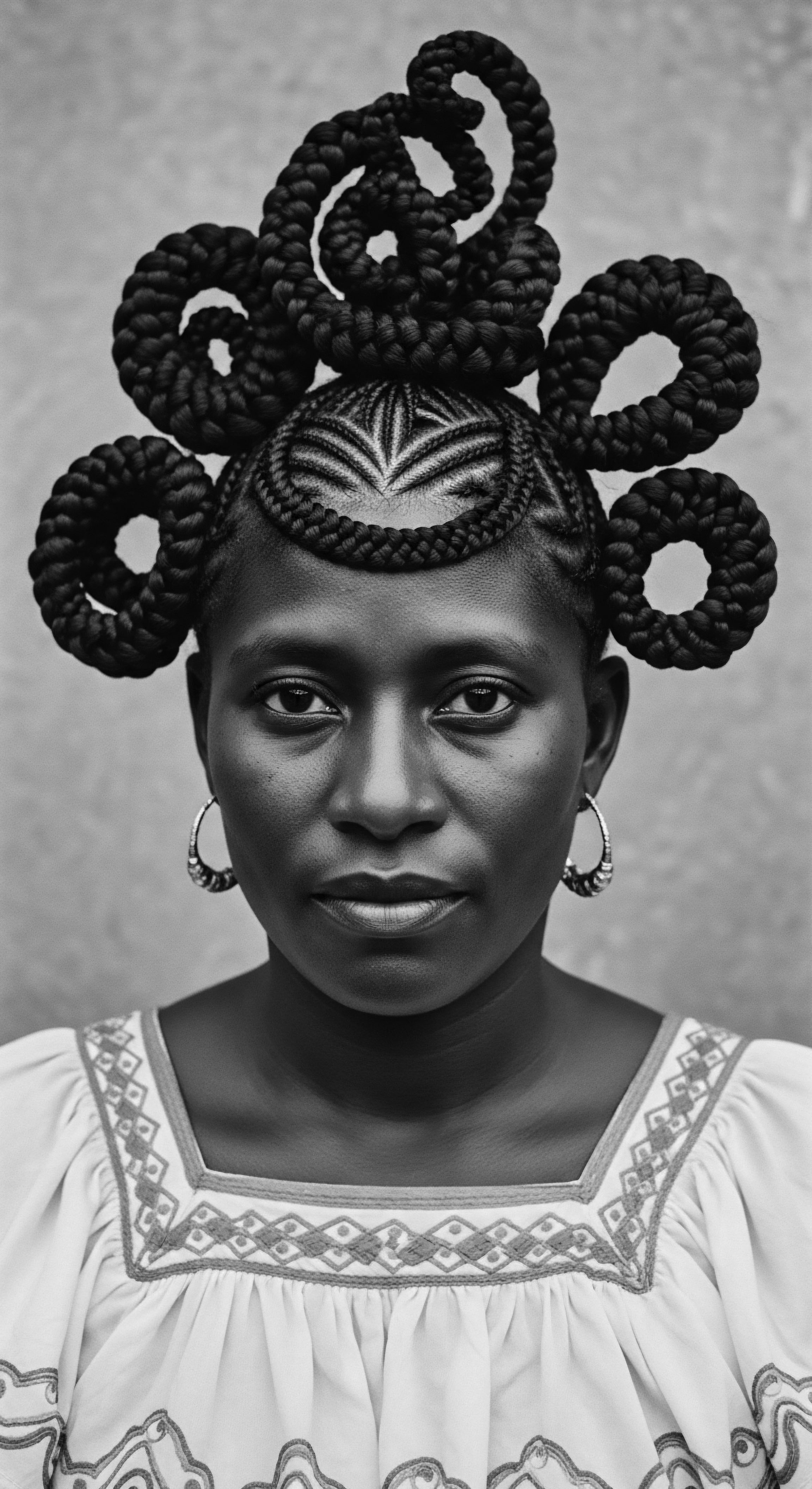
Post-Colonial Resonances and Identity Politics
The academic inquiry into coiled hair conditioners also critically examines their function within post-colonial identity politics. The historical subjugation of African hair textures, often deemed “unruly” or “unprofessional” by Eurocentric beauty standards, necessitated chemical alteration (relaxers) or concealment. In this context, the development and popularization of specialized coiled hair conditioners, particularly during the Natural Hair Movement waves of the late 20th and 21st centuries, represent acts of resistance and reclamation. These products facilitate the wearing of natural textures, thereby challenging hegemonic beauty norms and affirming Black and mixed-race aesthetic sovereignty.
The act of conditioning, in this sense, becomes more than a step in a beauty routine; it is a political statement. It supports a return to ancestral hair forms, fostering self-acceptance and celebrating a heritage that was historically denigrated. The market for coiled hair conditioners, while now globalized, owes its foundational demand to the persistent needs and cultural resilience of communities who refused to abandon their innate hair identity. This economic sphere also reflects power dynamics, with a historical shift from smaller, Black-owned businesses to larger corporations, a subject of ongoing academic scrutiny regarding equity and cultural appropriation.
| Aspect Key Ingredients |
| Ancestral Practices (Pre-20th Century) Shea butter, palm oil, moringa oil, hibiscus, various plant mucilages, natural clays. |
| Modern Formulations (21st Century) Cationic surfactants, polymers (e.g. polyquaterniums), silicones, hydrolyzed proteins, humectants (e.g. glycerin), botanical extracts. |
| Aspect Application Method |
| Ancestral Practices (Pre-20th Century) Often applied as leave-on balms or rinses, integrated into daily communal grooming rituals. |
| Modern Formulations (21st Century) Rinse-out, leave-in, or deep conditioning treatments; often part of a multi-step regimen. |
| Aspect Primary Function |
| Ancestral Practices (Pre-20th Century) Softening, detangling, protection from elements, promoting growth through scalp health. |
| Modern Formulations (21st Century) Cuticle smoothing, moisture retention, elasticity improvement, heat protection, color preservation. |
| Aspect Cultural Role |
| Ancestral Practices (Pre-20th Century) Direct connection to lineage, status, community identity; essential for maintaining traditional styles. |
| Modern Formulations (21st Century) Facilitates natural hair movement, self-acceptance, individual expression; market-driven but culturally resonant. |
| Aspect The evolution of coiled hair conditioning reflects a continuous adaptation of scientific understanding to the timeless needs and cultural significance of textured hair. |
Furthermore, the meaning of coiled hair conditioners is refracted through the lens of psychological well-being. For many, the ability to manage and style their natural hair without excessive struggle directly correlates with self-esteem and body image. Products that genuinely cater to the unique characteristics of coiled hair contribute to a positive hair journey, reducing frustration and fostering a sense of pride in one’s inherited texture. This psycho-social dimension underscores the academic necessity of understanding not just what these conditioners do to the hair fiber, but what they signify for the individual psyche and collective cultural identity.
The academic understanding thus reveals that ‘Coiled Hair Conditioners’ are far more than mere cosmetic aids. They are complex agents operating at the intersection of material science, historical sociology, and personal identity. Their continued development and application are a testament to the resilience of textured hair, the enduring wisdom of ancestral practices, and the ongoing quest for beauty and self-determination within Black and mixed-race communities.
- Cationic Surfactants ❉ These positively charged molecules adhere to the negatively charged hair surface, smoothing the cuticle and reducing frizz.
- Hydrolyzed Proteins ❉ Smaller protein fragments penetrate the hair shaft, temporarily strengthening the keratin structure and improving elasticity.
- Emollients and Humectants ❉ Ingredients like vegetable oils, butters, and glycerin work to attract and seal moisture, preventing dryness and brittleness.
Each component is strategically chosen to address the specific challenges presented by the coiled structure, enhancing both the physical integrity and the aesthetic appeal of the hair. This intricate formulation is a modern echo of ancestral ingenuity, a continuation of the deep care passed down through generations.
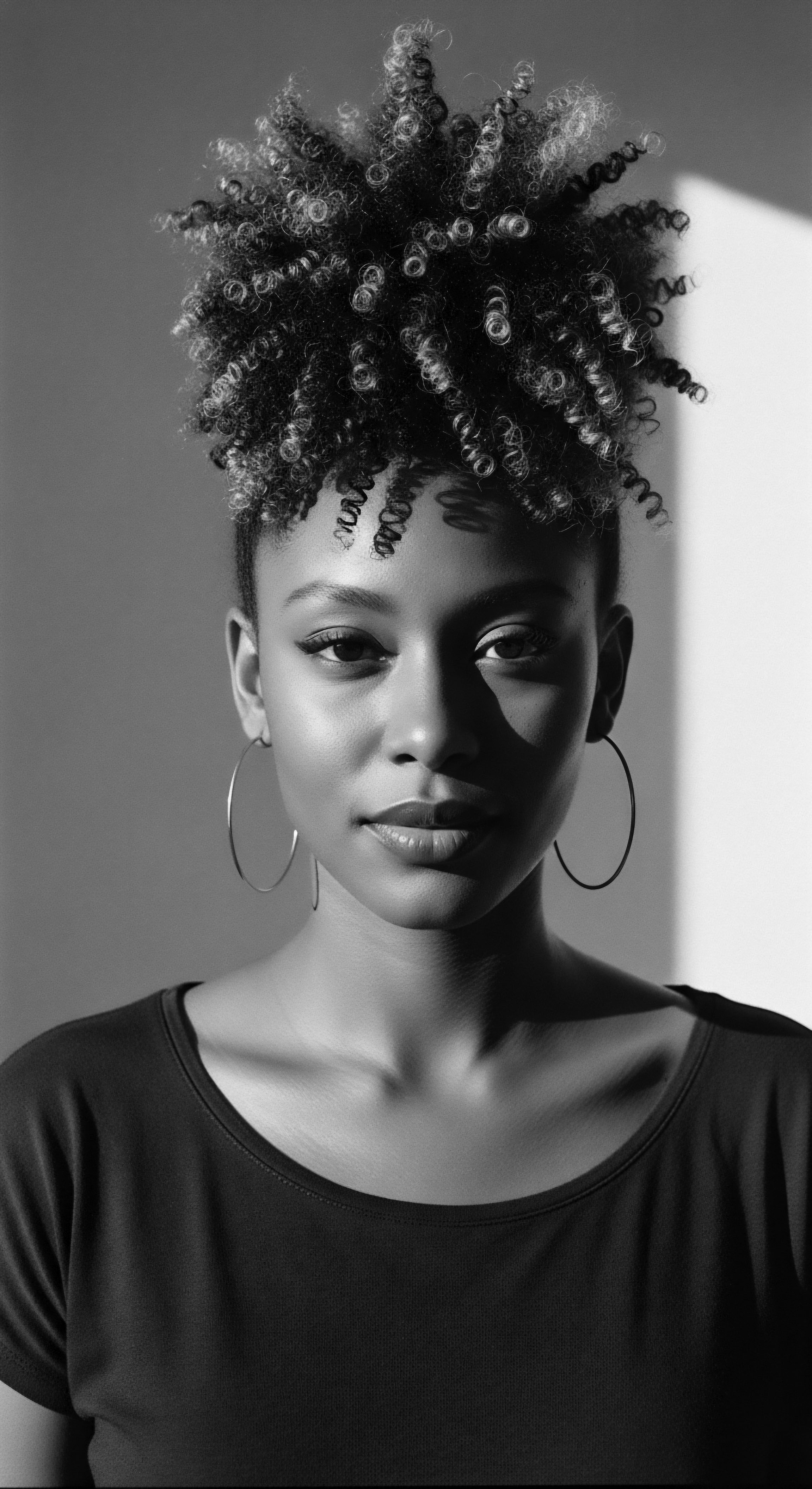
Reflection on the Heritage of Coiled Hair Conditioners
To truly grasp the enduring significance of ‘Coiled Hair Conditioners’ is to understand that they are not just concoctions of chemicals or botanicals; they are conduits of memory, vessels of resilience, and affirmations of identity. Their meaning is steeped in the rich soil of textured hair heritage, a lineage that stretches back through time, across continents, and into the very soul of Black and mixed-race existence. We witness a profound, unbroken thread connecting the rudimentary use of ancestral oils and plant extracts to the sophisticated formulations lining shelves today. This continuum speaks to an unchanging, fundamental human desire ❉ to nurture, protect, and celebrate the hair that grows from our very being.
The care of coiled hair, particularly through conditioning, has always been an act of profound self-love and cultural preservation. It has been a quiet rebellion against narratives of inadequacy, a steadfast insistence on beauty on our own terms. Every application, every detangling session, echoes the hands of grandmothers, mothers, and aunties who, with patient fingers and inherited wisdom, tended to the coils of their kin. This practice cultivated not just healthy hair, but also a resilient spirit, a sense of belonging, and an unwavering pride in one’s unique heritage.
The journey of ‘Coiled Hair Conditioners’ is a living testament to ingenuity—an ingenuity born of necessity and shaped by a deep reverence for the body. It reminds us that knowledge is often embodied, passed through touch and tradition long before it is codified in textbooks. The advancements in hair science, rather than eclipsing ancestral wisdom, frequently illuminate and validate the effectiveness of practices honed over centuries. This reciprocal relationship between ancient insight and modern discovery creates a harmonious understanding of care for coiled textures.
The heritage of coiled hair conditioners embodies a continuous, profound dialogue between ancestral wisdom and modern ingenuity, affirming beauty and resilience.
As we look forward, the meaning of ‘Coiled Hair Conditioners’ will undoubtedly continue to expand. Yet, its core essence—that of honoring, hydrating, and empowering coiled strands—will remain steadfast. These products, whether traditional or cutting-edge, serve as an invitation to engage with our hair not as a challenge, but as a sacred expression of our past, present, and future. They whisper tales of survival, triumph, and the unbound beauty of every unique helix, reminding us that true wellness begins with acknowledging and celebrating the legacy within each strand.
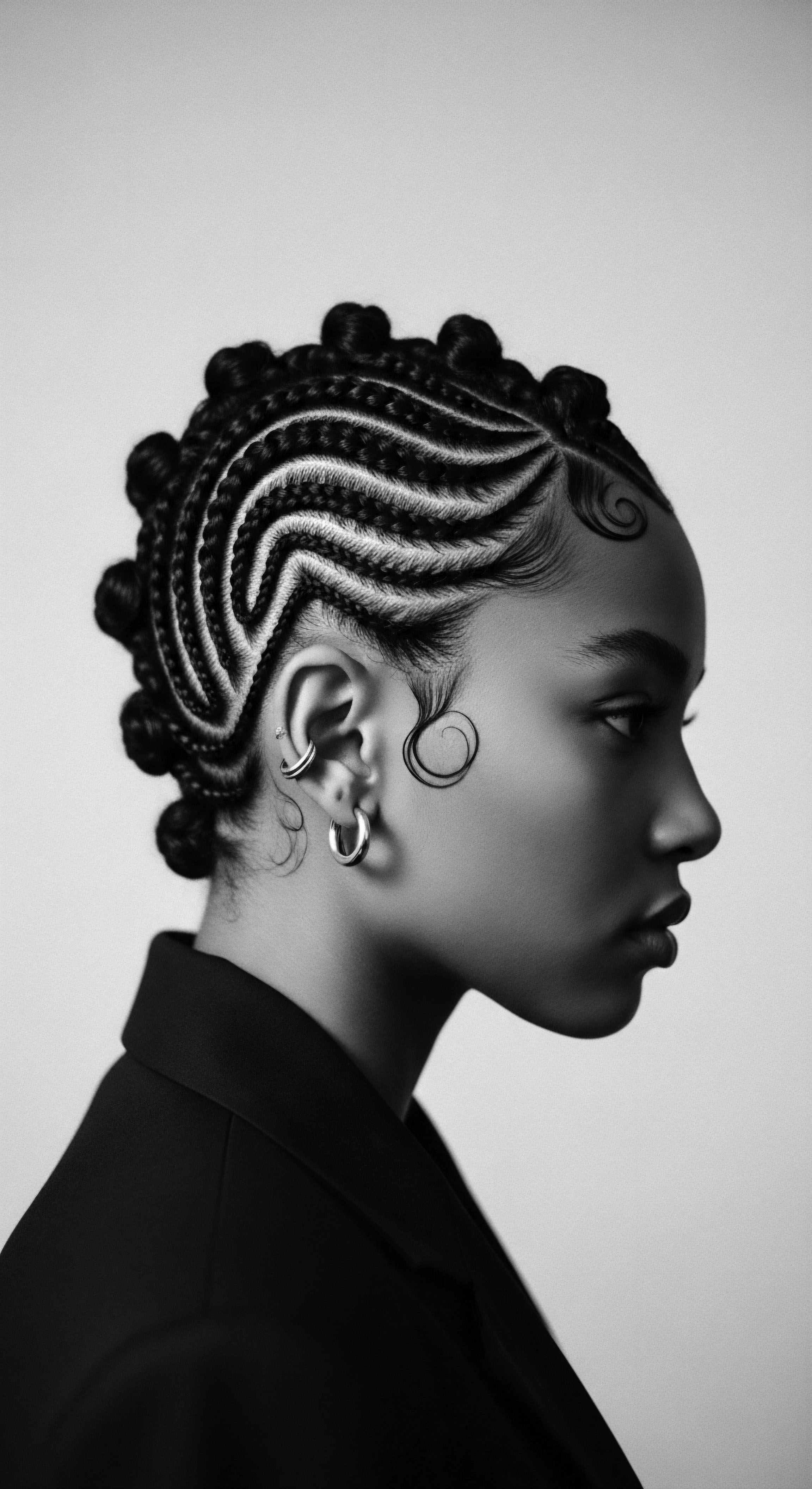
References
- Opoku, R. & Akweley, L. (2017). The Cultural Significance of Shea Butter in Ghanaian Society. University of Ghana Press.
- Ellis, A. M. (2001). Hair Story ❉ Untangling the Roots of Black Hair in America. St. Martin’s Griffin.
- Byrd, A. D. & Tharps, L. L. (2014). Hair Story ❉ The Definitive Historical Account of Black Hair in America. St. Martin’s Press.
- Robbins, C. R. (2012). Chemical and Physical Behavior of Human Hair. Springer.
- Gabourel, G. (2003). African Hairstyles ❉ Styles of Yesterday and Today. Africa World Press.
- Cole, R. (2009). The Materiality of Hair ❉ Hair as a Communicative Medium in Cultural Practices. Palgrave Macmillan.
- Gittleson, G. (2013). Body of Work ❉ The Art of Hair and the Human Story. Thames & Hudson.
- Holder, C. (2007). African American Hairstyles ❉ An Art Form and Social Statement. Greenwood Press.
